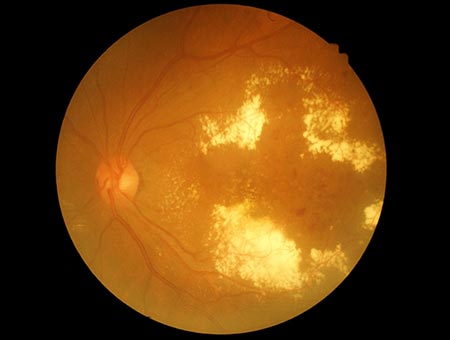The retina is the light-sensitive tissue lining the back of your eye. Light rays are focused onto the retina through our cornea, pupil, and lens.
The retina converts the light rays into impulses that travel through the optic nerve to our brain, where they are interpreted as the images we see.
A healthy, intact retina is key to clear vision.

Patients with diabetes can have an eye disease called diabetic retinopathy. This is when high blood sugar levels cause damage to blood vessels in the retina, which is the light-sensitive tissue that lines the back of the eye. These blood vessels can swell and leak, or they can close, stopping blood from passing through. Sometimes abnormal new blood vessels grow on the retina. All of these changes to the retina can cause permanent vision loss.
The condition can develop in anyone who has Type 1 or Type 2 diabetes. The longer you have diabetes and the less controlled your blood sugar is, the more likely you are to develop this eye complication.
Macular Degeneration is the leading cause of vision loss, affecting more than 10 million Americans – more than cataracts and glaucoma combined!
At present, macular degeneration is considered an incurable eye disease, which is caused by the deterioration of the central portion of the retina known as the macula.
The macula is responsible for focusing central vision in the eye, and it controls the ability to read, drive a car, recognize faces or colors, and see objects in fine detail. There is no known cure for macular degeneration, but with regular eye exams, you will be informed of the latest treatments that might slow down the progression of the disease.
A branch retinal artery occlusion is also known as an “eye stroke.” Eye strokes occur when blockages (occlusions) occur in arteries or veins in the retina, causing vision loss.
The severity of vision loss depends on the extent and location of the occlusion(s) and loss of blood flow. Just as strokes occur in other parts of the body because blood flow is blocked, your eye also may suffer damage when vital structures such as the retina and optic nerve are cut off from nutrients and oxygen flow through your blood.
You may see a sudden flash of light in your vision or lightning streaks when the vitreous gel inside your eye rubs or pulls on the retina. You may have experienced this sensation if you have ever been hit in the eye.
These flashes of light can appear off and on for several weeks or months. As we grow older, it is more common to experience flashes. If you notice the sudden appearance of flashes, it could mean that the retina has been torn.
Floaters are specks or clouds moving in your field of vision. You may see them more clearly when looking at a plain background, such as a blank wall. Floaters are tiny clumps of gel or cells inside the vitreous, the clear jelly-like fluid that fills the inside of your eye. Floaters can have different shapes, such as little dots, circles, lines, clouds, or cobwebs.
Flashes and floaters become more common as we grow older. While not all flashes and floaters are serious, you should call our office at ☎ (210) 806-0022 and schedule an appointment with Dr. Baribeau right away so he can evaluate the health of your retina.
The retina normally lies smoothly and firmly against the inside back wall of the eyeball and functions much like the film in the back of a camera. Millions of light-sensitive retinal cells receive optical images, instantly "develop" them, and send them on to the brain to be seen. If any part of the retina is lifted or pulled from its normal position, it is considered detached and will cause some vision loss.
A detached retina occurs when the retina is pulled away from its normal position in the back of the eye. The retina sends visual images to the brain through the optic nerve. When detachment occurs, vision is blurred. The most common symptoms are:
A detached retina is a serious problem that can cause blindness unless it is treated.
Call our office at ☎ (210) 806-0022 or contact us online and schedule a comprehensive annual eye exam with Dr. Baribeau today!
Baribeau Cataract and Laser
4025 East Southcross Blvd, Building 4, Suite 20
San Antonio, TX 78222
Phone:
(210) 806-0022
Get Directions